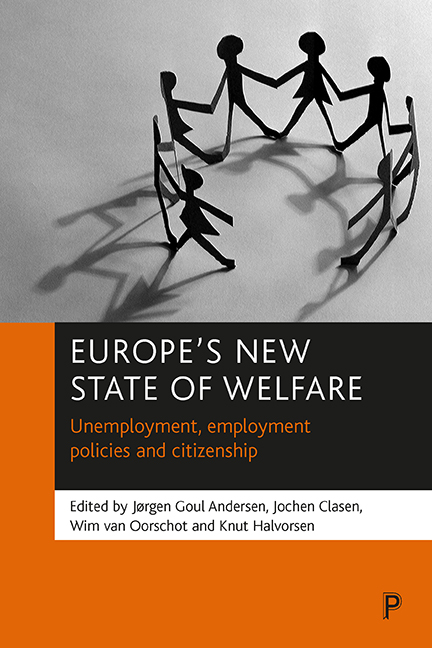Book contents
- Frontmatter
- Contents
- Notes on contributors
- Glossary
- Preface
- one Changing labour markets, unemployment and unemployment policies in a citizenship perspective
- two Employment and unemployment in Europe: overview and new trends
- three Unemployment and unemployment policy in the UK: increasing employability and redefining citizenship
- four To be or not to be employed? Unemployment in a ‘work society’
- five France: the impossible new social compromise?
- six Labour market participation in the Netherlands: trends, policies and outcomes
- seven Is high unemployment due to welfare state protection? Lessons from the Swedish experience
- eight Denmark: from the edge of the abyss to a sustainable welfare state
- nine Unemployment and (un)employment policies in Norway: the case of an affluent but oil-dependent economy: the paradox of plenty?
- ten Unemployment and unemployment policy in Finland
- eleven Slovenia’s navigation through a turbulent transition
- twelve Unemployment and unemployment policy in Switzerland
- thirteen Work, welfare and citizenship: diversity and variation within European (un)employment policy
- References
- Index
- Also available from The Policy Press
eight - Denmark: from the edge of the abyss to a sustainable welfare state
Published online by Cambridge University Press: 20 January 2022
- Frontmatter
- Contents
- Notes on contributors
- Glossary
- Preface
- one Changing labour markets, unemployment and unemployment policies in a citizenship perspective
- two Employment and unemployment in Europe: overview and new trends
- three Unemployment and unemployment policy in the UK: increasing employability and redefining citizenship
- four To be or not to be employed? Unemployment in a ‘work society’
- five France: the impossible new social compromise?
- six Labour market participation in the Netherlands: trends, policies and outcomes
- seven Is high unemployment due to welfare state protection? Lessons from the Swedish experience
- eight Denmark: from the edge of the abyss to a sustainable welfare state
- nine Unemployment and (un)employment policies in Norway: the case of an affluent but oil-dependent economy: the paradox of plenty?
- ten Unemployment and unemployment policy in Finland
- eleven Slovenia’s navigation through a turbulent transition
- twelve Unemployment and unemployment policy in Switzerland
- thirteen Work, welfare and citizenship: diversity and variation within European (un)employment policy
- References
- Index
- Also available from The Policy Press
Summary
Introduction
At the beginning of the 21st century, Denmark ranks among the European countries that have recovered quite convincingly from the employment crisis. Around 1980, Denmark was described as balancing on the edge of the abyss, but 20 years later, it is sometimes held up as a ‘model country’ for a European third way in a globalised economy (Auer, 2000). Indeed the Danish experience has demonstrated that there are alternatives to the market-oriented reforms advocated by OECD (1994c, 1997b) and others. The Danish experience also seems to speak against the very idea of structural or a natural level of unemployment as a guide to policy – or at least against the estimation and interpretation of it. Until the mid-1990s, structural unemployment was normally estimated at around 10% (Finansministeriet, 1993, 1996, 1999; OECD, 1997a), indicating that nearly all unemployment was structural. From 1993 to 1998, however, the standardised unemployment rate declined rapidly from 9.6% to 4.9% (Chapter Two, Table 2.1 of this volume) without inflationary consequences. And the improvement has been stable – by mid-2002, the unemployment rate was 4.2%.
As this economic turn has happened concurrently with the adoption of new labour market policies, it would be tempting to suggest a relationship. However, whereas the Danish experience clearly seems to speak against the necessity of die-hard market oriented reforms, it is contested what exactly explains the improvements:
• Active labour market policy (as emphasised by the Social Democratic government)?
• Tightened eligibility criteria (equally important, according to the Ministry of Finance)?
• Danish ‘flexicurity’ – the combination of liberal employment protection and generous protection of the unemployed (Madsen, 2002)?
• Employment-friendly financing of welfare almost exclusively through general taxes, without social contributions (Scharpf, 2000)?
• The switch to ‘sound’ economic policies (Goul Andersen, 2002c)?
• Innovative technology (for example environmental technology), and organisation (modern corporate governance)?
• Luck (Schwartz, 2000) – including quite significant oil revenues?
There are counter-arguments against most of these explanations. Individuallevel evaluations of activation effects have been rather negative (Larsen, 2002a), tightening has after all been quite moderate (see below) and the problem with explanations referring to ‘flexicurity’ or ‘employment-friendly financing’ is that these characteristics were also there during the crisis ten years earlier.
- Type
- Chapter
- Information
- Europe's New State of WelfareUnemployment, Employment Policies and Citizenship, pp. 143 - 162Publisher: Bristol University PressPrint publication year: 2002

